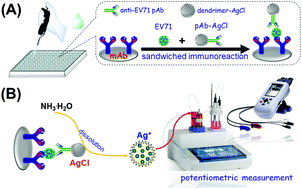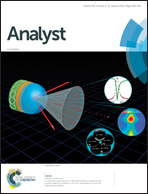A potentiometric immunosensor for enterovirus 71 based on bis-MPA-COOH dendrimer-doped AgCl nanospheres with a silver ion-selective electrode
Abstract
Herein a new potentiometric immunoassay for the point-of-care detection of enterovirus 71 (EV71) was developed by using a silver (Ag+) ion-selective electrode (ISE). Initially, the carboxylated dendrimer-doped AgCl nanospheres were synthesized by the reverse micelle method. Then the synthesized nanospheres were used to label a polyclonal mouse anti-EV71 antibody via a typical carbodiimide coupling method. The immunoreaction was executed on a monoclonal anti-EV71 antibody-coated microplate by using biofunctional AgCl nanospheres as the detection antibody. With a sandwich-type immunoassay format, the carried AgCl nanospheres could be dissolved in the presence of NH3·H2O, and the released silver ions were determined with an external silver ion-selective electrode. Under optimal conditions, the shift in the potential increased with the increase in the EV71 concentration, in a wide linear range of 0.3–300 ng mL−1, with a detection limit of 0.058 ng mL−1. Intra- and inter-assay relative standard deviations with identical batches were less than 4.15% and 6.15%, respectively. By validating the spiked serum samples, our system shows consistency with the enzyme-linked immunosorbent assay (ELISA) kit.



 Please wait while we load your content...
Please wait while we load your content...